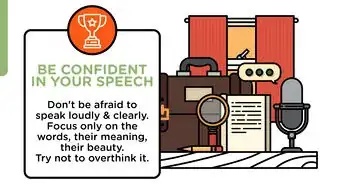This article was co-authored by Lynn Kirkham and by wikiHow staff writer, Christopher M. Osborne, PhD. Lynn Kirkham is a Professional Public Speaker and Founder of Yes You Can Speak, a San Francisco Bay Area-based public speaking educational business empowering thousands of professionals to take command of whatever stage they've been given - from job interviews, boardroom talks to TEDx and large conference platforms. Lynn was chosen as the official TEDx Berkeley speaker coach for the last four years and has worked with executives at Google, Facebook, Intuit, Genentech, Intel, VMware, and others.
There are 10 references cited in this article, which can be found at the bottom of the page.
wikiHow marks an article as reader-approved once it receives enough positive feedback. In this case, 80% of readers who voted found the article helpful, earning it our reader-approved status.
This article has been viewed 58,141 times.
No matter your line of work, other people form fast opinions on you based on what you say and how you say it. Speaking professionally means that you communicate with clarity and confidence, putting listeners at ease while also informing and persuading them. If you’re looking for ways to improve, you can learn a lot by observing and getting feedback from skilled speakers. From there, take the time to practice your speaking style and nonverbal communication skills.
Steps
Getting Inspiration and Feedback
-
1Watch and learn from exceptional public speakers. Don’t try to copy someone else’s speaking style, because you won’t sound or look genuine. Instead, draw inspiration from people with great speaking skills.[1] Note where they excel, and adapt those qualities to suit your personality and talents.[2]
- Observe exceptional speakers in person when you get the chance. Pay close attention to an engaging lecturer, a co-worker who is great at client presentations, or a politician who knows how to electrify a crowd.
- You can also watch great speakers online. Check YouTube for well-known public speakers, or check out the recordings of TED talks.
-
2Take note of successful speakers in your company or field. In addition to watching for the quality of their speaking abilities, pick up on the vocabulary, style, and energy level that works best in your field. Draw inspiration from them without trying to mimic their exceptional speaking qualities.
- You might, for example, notice that people who advance more quickly in your company use less corporate jargon when they speak. If so, keep this in mind when it’s time for you to make a presentation.
Advertisement -
3Join a public speaking organization like Toastmasters. Toastmasters International is one of several groups that offers people a way to improve their public speaking skills. If you join such a group, you’ll get to practice your speaking abilities alongside other individuals who are trying to achieve the same goal.[3]
- You can also look for low-pressure public speaking opportunities in your area. For instance, a local chamber of commerce, historical society, or charitable organization might be on the lookout for speakers.
-
4Welcome constructive feedback from numerous sources. You should always view honest feedback as a learning opportunity, not something to be embarrassed or resentful about. Whether it’s your boss, mentor, friend, or fellow Toastmaster offering the feedback, listen carefully and thoughtfully. The more feedback you can get, the better![4]
- For instance, if you hear from several people that you tend to talk too fast, you’ll know you need to work on maintaining a slower speaking pace.
- You might get opposing feedback from two different people, though. For example, one person may think you were too jokey, while another might really appreciate the humor you sprinkled in. In this case, you may need to prioritize whose feedback you value the most.
-
5Work with a public speaking or communication coach. Depending on the nature of your job and the amount of professional communication it requires, your HR department may be able to line you up with a public speaking coach. Otherwise, you can search online for “public speaking coaches” in your area.[5]
- Training sessions with a coach may help you improve your delivery style, body language, speaking voice, and overall confidence.
- Look for a coach who works with your natural attributes, rather than trying to impose a “one-size-fits-all” public speaking style.
Improving Your Vocabulary and Delivery
-
1Replace filler words with pauses. Peppering your speech with “ums,” “uhs,” “likes,” and “you knows” quickly becomes distracting for listeners. Filler words like these also make what you say sound less professional. To stop using filler words, begin by accepting that a silent pause isn't a bad thing.[6]
- Brief pauses of 1-3 seconds, and sometimes even longer ones, indicate that you are both thoughtful and focused on clarity.
- Try pressing your tongue to the roof of your mouth, just behind your front teeth, during times when you’re tempted to utter a filler word. This little trick can help train you to avoid them and use pauses instead.
-
2Don’t use complex words when simple ones will do. Speaking professionally should not be an excuse to show off how large your vocabulary is. Shorter, simpler, more common words are easier to follow for listeners, and make it less likely that you’ll be misunderstood or misinterpreted.[7]
- For instance, don’t say, “when we juxtapose the ways in which these two divergent groups utilize the product,” when you can instead say, “when we compare how these two different groups use the product.”
- Adjust your vocabulary to suit your audience. You can use more technical terms or “insider” phrases when speaking to an audience that you know will be able to follow along.
-
3Cut out slang and potentially offensive vocabulary. Avoid cursing and foul language, and be especially careful with your vocabulary when speaking to an unfamiliar audience. Play it safe to reduce your chances of turning off or offending anyone.[8]
- For instance, seemingly innocuous phrases like “that’s b.s.” or “swear to God” might offend some people. Also, they lack the air of professionalism you should be aiming for.
- Even if you’re trying to be folksy, avoid saying things like “ain’t.” Likewise, avoid using abbreviations, acronyms, hashtags, or other slang phrases to show how "trendy" you are.
-
4Choose your “pivot phrases” carefully. The few words you use to transition from one thought or subject to the next can have a big impact on the overall professionalism of your speech. Take the time to carefully choose “pivot phrases” that match the tone of your speech in general.[9]
- For instance, don’t transition with, “So, anyways,” or, “OK, anyhow.” Instead, use something like, “Let’s move on to…” or, “Another aspect to consider…”.
-
5Communicate in the active voice, not passively. Using the active voice offers more immediacy to both written and spoken communication. This is especially important if your speech is meant to be persuasive or inspirational.[10]
- An active voice sentence usually follows the form of subject—verb—object, with the verb expressing the action taken by the subject on the object (e.g., "The dog ate my homework."). A passive voice sentence usually is in the form of subject—verb—agent, with the verb expressing the action taken by the agent upon the subject (e.g., "My homework was eaten by the dog.").
- For example, compare the following: “Project X will be completed by us next Tuesday." “We will complete Project X next Tuesday.”
- Passive voice is sometimes preferable, however, such as in scientific or technical contexts when generality or universality is the goal.
-
6Adjust the speed of your delivery based on the content. Speaking either too fast or too slow is distracting and hard to follow.[11] However, that doesn’t mean you should speak at the same medium pace throughout your entire speech. Doing so will make you sound robotic and emotionless.[12]
- For instance, you might speak a bit more quickly when you’re summarizing or recapping content, then slow down a little more when you’re introducing something new.
- Speaking a little faster is also a way to build up some more enthusiasm, while slowing down helps you to hammer home a key point.
Working on Nonverbal Communication
-
1Smile genuinely, even if you’re speaking on the phone. Smiling while you speak gives your voice a friendlier tone and helps build a rapport with your listeners. Therefore, smiling helps even if your listeners can’t actually see your face![13]
- This only works with genuine smiles, however. A forced, faked smile won’t have the same effect, and may make you seem untrustworthy.
- If you aren’t in a smiling mood, try to think of something happy, right before speaking or even during your talk.
- In addition to smiling while talking on the phone, work on other forms of nonverbal communication, like posture and hand gestures. It makes a difference!
-
2Display polite confidence with your posture and hand gestures. Maintain good posture when you're standing or sitting, keeping your back straight—but not so rigidly upright that you’re uncomfortable. Keep your hands visible, not in your pockets or crossed behind your back, and use hand gestures that reveal your open palms.[14]
- If you’re standing, keep your feet at shoulder width or slightly wider.
- The overall goal here is to project confidence by making yourself appear a bit larger and more open. You don’t want to appear too aggressive or dominant, however—by gesturing with clenched fists, for example.
-
3Keep your head up and make regular eye contact. Speaking with your head down, and especially your eyes down, indicates a lack of confidence. Keep your head in a neutral position, and look directly at your audience as much as possible.[15] [16]
- Reduce how often you have to look at notes by memorizing your speech, or practicing what you want to say so it comes naturally.
- If looking people right in the eyes distracts you, focus on the tops of their heads instead.
- Don’t stare directly at someone for more than 10-15 seconds. Move on to someone else, or break eye contact for about 5 seconds, then return it.
-
4Improve your listening skills along with your speaking abilities. Speaking professionally and listening professionally go hand-in-hand. Whether you’re dealing with clients or co-workers, well-rounded communication skills are vital to professional success.[17]
- Make eye contact while the other person is speaking.
- Nod your head and make brief affirmations like “mm-hmm” or “I see” to show that you’re listening.
- Quickly summarize what they’ve said when it’s your turn to speak: “So what you’re saying is…”
Community Q&A
-
QuestionHow can I become a better speaker of the English language?
 Community AnswerBy immersing yourself in it as much as possible. Converse in English with native speakers. Read English publications, listen to podcasts, and watch TV and movies in English.
Community AnswerBy immersing yourself in it as much as possible. Converse in English with native speakers. Read English publications, listen to podcasts, and watch TV and movies in English.
References
- ↑ Lynn Kirkham. Public Speaking Coach. Expert Interview. 20 November 2019.
- ↑ https://www.forbes.com/sites/nickmorgan/2016/10/04/want-to-speak-professionally-here-are-five-quick-tips-to-get-you-started/#56cecb1f3ab1
- ↑ https://www.forbes.com/sites/nickmorgan/2016/10/04/want-to-speak-professionally-here-are-five-quick-tips-to-get-you-started/#56cecb1f3ab1
- ↑ https://www.nbcnews.com/better/health/9-ways-anyone-can-be-better-public-speaker-ncna779896
- ↑ Lynn Kirkham. Public Speaking Coach. Expert Interview. 20 November 2019.
- ↑ https://bizfluent.com/how-4511094-speak-more-professionally.html
- ↑ https://www.indeed.com/career-advice/career-development/how-to-be-good-speaker
- ↑ https://www.plainlanguage.gov/guidelines/words/avoid-jargon/
- ↑ https://www.cob.calpoly.edu/handbook/effective-transitions-and-pivots/
- ↑ https://courses.lumenlearning.com/suny-esc-communicationforprofessionals/chapter/active-voice/
- ↑ Lynn Kirkham. Public Speaking Coach. Expert Interview. 20 November 2019.
- ↑ https://www.inc.com/geoffrey-james/9-speaking-habits-that-make-you-sound-smarter.html
- ↑ https://www.linkedin.com/pulse/smile-when-you-speak-even-phone-shawna-baker/
- ↑ https://bizfluent.com/how-4511094-speak-more-professionally.html
- ↑ Lynn Kirkham. Public Speaking Coach. Expert Interview. 20 November 2019.
- ↑ https://www.inc.com/geoffrey-james/9-speaking-habits-that-make-you-sound-smarter.html
- ↑ https://www.forbes.com/sites/nickmorgan/2016/10/04/want-to-speak-professionally-here-are-five-quick-tips-to-get-you-started/#56cecb1f3ab1














































































